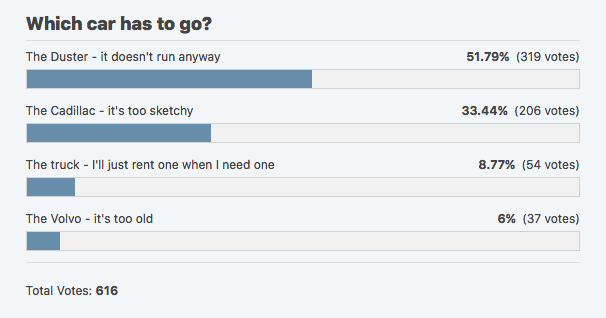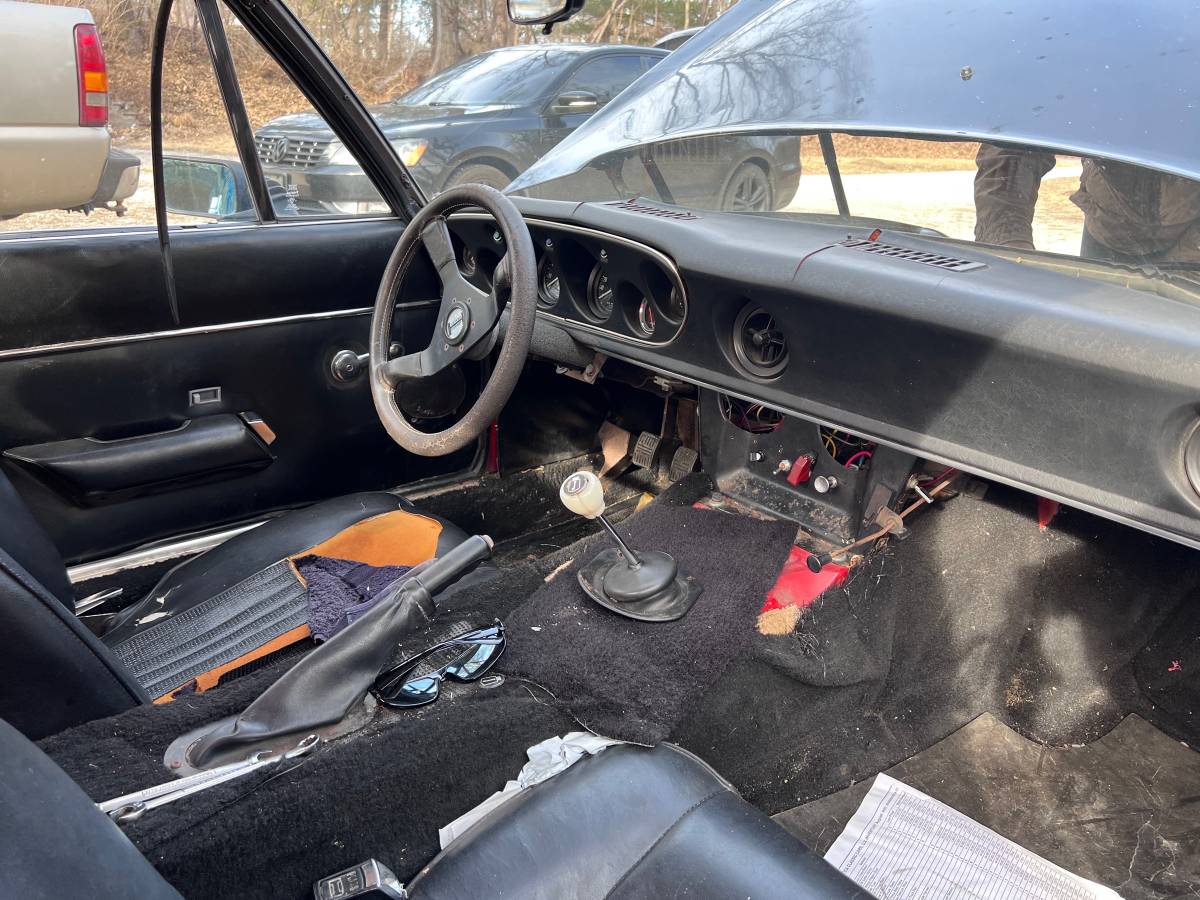Welcome back to Shitbox Showdown! Today we have a pair of sporty little numbers plucked straight from our Discord. But before we get to those, on Friday, we had four cars to choose from, but you could only keep three. Let’s see which one got left out in the cold:

Aw, man. Economy-minded Chrysler products are the Rodney Dangerfields of the used car market: they get no respect. Oh well. If it matters, I’d ditch the suspect Caddy and fix up that poor Duster.
Today’s choices were suggested on the Shitbox Showdown channel of our Discord server, by two of our most active posters: Toecutter and Rootwyrm. Thanks for the suggestions, guys! I struggled to find a common theme between the two, but then it struck me: Both have twin-cam four-cylinder engines.
Nearly all four-cylinder engines these days have dual overhead camshafts, but that hasn’t always been the case. The technology isn’t new; Peugeot built a race car way back in 1912 with a twin-cam four. And for a long time, two camshafts on top of the engine meant it was something special. But then the technology trickled down, like it always does, and now every Kia Rio and Chevy Spark is running around with twin cams. So for today, we’re looking at a car from the days when twin cams were exotic, and one from after it became commonplace. (There, I knew I’d find a link between them.) Let’s check them out.
1974 Jensen-Healey MkII – $3,000

Engine/drivetrain: 2.0 liter dual overhead cam inline 4, four-speed manual, RWD
Location: Florrisant, MO
Odometer reading: 65,000 miles
Runs/drives? Says it was running in November, but…
There is a hierarchy of cool when it comes to British sports cars. MGBs, I have to admit, are towards the bottom, simply because they’re so common. But chrome-bumper MGBs are cooler than rubber-bumpers, and GTs are cooler than roadsters, so there’s that. Spitfires and Midgets are down the ladder a ways, too. Triumph is a little higher up, as are MGAs, then Austin-Healey, then Sunbeam, then Jaguar. Up at the top you have Morgan and Lotus and TVR and AC. But if you really want to separate yourself from the hoi polloi, get yourself a Jensen.

Better known for its big, badass, Chrysler big-block-powered Interceptor coupe, Jensen also took a stab at the roadster market in the early ’70s with a little help from Donald Healey and Lotus. Healey oversaw the car’s development, and Lotus supplied their two-liter 907 engine, the first mass-produced DOHC sixteen-valve four. This one, with its two big sexy Dell’Orto side-draft carbs, appears to be a European-spec car, or have been retrofitted.
The seller says this engine was running as recently as November, but it’s not like you can just hop in and fire it up and drive off; the brake master cylinder is completely missing. Luckily, from what I’ve read, it’s the same master cylinder as a Triumph TR6, so a replacement is easy to get. Hopefully the brake lines haven’t been sitting open to the elements since November; that could be a bigger problem.

The rest of the car is scruffy, but not unreasonably so for a nearly fifty-year-old British car. The upholstery is shot, the dash is cracked, but it’s all there. The center console and some other interior bits have been removed, but they’re included.

[Editor’s Note: Those are the same taillights used on the Reliant Scimitar GTE! — JT]
What doesn’t appear to be included are the bumpers. If this is a European-market car, it should have the thin chrome bumpers on it instead of the big heavy rubber battering rams of the US model; I’m not sure why you’d take the chrome ones off. It does look pretty good without the bumpers, though. The paint is still shiny too, and I don’t see any glaring signs of rust. It also includes the factory hardtop, and is that a roll bar I see peeking out of the back window?
2000 Toyota Celica GT – $2,000

Engine/drivetrain: 1.8 liter dual overhead cam inline 4, five-speed manual, FWD
Location: South Euclid, OH
Odometer reading: 219,000 miles
Runs/drives? Yep
Nobody seeme to be able to agree on the definition of a “sports car.” Most would agree that two doors and a manual transmission are requirements; some would argue that front-wheel-drive is an automatic disqualifier. Others go much further and state that a real sports car doesn’t even have roll-up windows. (These folks can be seen making brief outings in their Morgans and MG TDs before spending months in the garage fixing things.) But as hard as it is to define what a sports car is, it’s sometimes easy to tell what it isn’t. And that’s the Toyota Celica. Sporty coupe? Sure. But real honest-to-goodness sports car? Nope.

This is the Celica’s swan song, the final iteration of a nameplate that started way back in 1971. It started out as sort of a “Japanese Mustang,” but parted ways from the American pony car in 1986 when it switched to front-wheel-drive. The Celica never was a fire-breather, but throughout its life the GT model was always just a little bit faster. In this case, that means a 2ZZ-GE 1.8 liter four with variable valve timing and lift, and a very un-Toyota-like thirst for oil.

The seller says this one runs and drives well, but doesn’t really elaborate. If it has passed 200,000 miles, that means someone has taken care of it and stayed on top of the oil consumption. It also means it hasn’t been abused or raced like so many of these were. Some engines can take a little abuse and high-revving. This isn’t one of them.

Cosmetically, it’s all right, I guess, but having spent sixteen years away from Rust Belt winters, I look at the crispiness around the rear wheel of this car and am appalled. But then I remember that everything rusts in the midwest, and this one isn’t even all that bad yet. The interior looks all right, but it could use a good cleaning.
There you have it: two twin-cam inline fours, installed in two swoopy two-door cars. One needs some work to get back on the road, and the other is a workhorse of a commuter. One is mundane and mass-produced on an assembly line, and the other is rare enough to almost be called exotic. Which one is more your speed?
(Image credits: Craigslist seller)







You comment on dual overhead cams? It may have not been as early as 1912, but the 1922 Diatto a friend’s parents owned had a twin cam alloy 4 cylinder engine, and while Diattos were apparently more known for race cars, this was a production car. But while it had twin cams, it had only rear brakes, no taillights, no seatbelts of course, wooden wheels, and all the other features of the average ’20s car. This was no museum piece, either – it rarely saw the inside of a garage, was on full registration and was often borrowed by the kids, in the same way most kids borrow a Corolla. (This family was a bit different to most, they ran a business building and modifying gearboxes for vintage road cars and race cars, and had lots of old cars scattered around – their son rented a factory that he had crammed with Minis and Austin 1800 utes – with only just over 2000 of these having been made, he owned a measurable fraction of their total production!)
Long-time reader first time commenter. I had a JH once. Don’t do it. By the Toyota and never look back. Traded mine for an XJS that was more mechanically sound in every way possible even when it wasn’t running which was often.
Amazingly, the Jensen looks to be the significantly less rusty option here, and it’s far more of a looker.
Edit: It now has the narrowest lead, 303 to 302…
Wow, I pulled the Jensen ahead by one vote? I think this is one of the better looking Celicas (except for the Celica/Supra) they are getting to be a rare sight around here. However that Jensen, is just too good looking… It would be worth the work,
Toy or transportation?
I got transportation, can wrench, and a toy would be nice – and the price is highly acceptable for a Jensen.
That Celica is not special enough to want for more than Toyota’s reputation for reliability and is truly at the end of it’s lifespan, based on the body rust.
Celica for me. Even if that Jensen Healey is running, chances are it will be one thing after another to keep it running.
Plus I’ve always liked that gen of Celica.
Never liked the look of these Celicas, I’m sure it drives like a “sporty” Toyota, and I don’t like high-rpm engines for the usual problems of lacking torque in 99.9% of driving and shorter lifespans. Not interesting enough for that. I don’t mind some problems from an obvious toy car that’s dirt simple to work on and I like vintage junk to begin with, so Jensen without hesitation.
“Never liked the look of these Celicas,”
“and I don’t like high-rpm engines”
From these two statements, I have determined that you are defective and are in need of some Oppo-therapy.
No thanks, you can save your re-education camp. The Celica is a lackluster FWD “sporty” overstyled wedge using the same platform as those paragons of driver engagement, the Corolla and Prius. Low torque/high rpm engines are only good for outright toys that are small and light enough to not need a lot of torque (so, like, nothing produced in volume), for OEM marketers to be able to advertise a high hp figure that makes a weak engine more salable, or—as was the original reason for so many of them—to beat taxation on displacement. For a daily driver, unless driven very gingerly, they just use more fuel since they’re under a higher load more often and the short gearing they require means higher rpm is hit more often to accelerate and sustained for cruising, they use more oil, are less tolerant of abuse or neglect, have increased internal wear, produce more emissions, and are noisier on the highway, requiring either tolerance or increased weight from sound mitigation. Maybe some people find the high rpm zing of a bland modern(ish) I4 inspiring, but I’m not so easily satisfied (however, I am very accepting of not having an engine that sounds good).
Cool to see my find made today’s Shitbox Showdown. So of course, I voted for it. I’d be looking to restore it, if I had a place and the time to do so. These are fun cars. It’s a better Triumph Spitfire than a Triumph Spitfire, at least in terms of driving dynamics and engine(I still prefer the Spitfire’s more slippery aerodynamics and smaller frontal area). That Lotus engine is a thing of beauty.